Choosing Handlebars
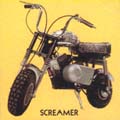
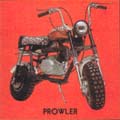
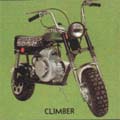
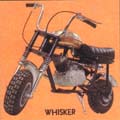
Let's explore the choice of comfortable versus practical versus period-accurate handlebars for your minibike...
Motocross handlebars, also known as MX handlebars or dirt-bike or minibike handlebars, are specially designed handlebars for off-road motorcycles used in motocross and other dirt bike disciplines. They are designed to provide riders with optimal control, comfort, and maneuverability while riding aggressively off-road. Here are some characteristics and features of motocross handlebars:
- Width: Motocross handlebars are typically wider than street bike handlebars to provide better stability and leverage while navigating rough terrain.
- Rise and Height: They often have a higher rise and increased height compared to street bike handlebars. The increased height helps riders maintain an upright and aggressive riding position while standing on the footpegs.
- Bend: Motocross handlebars have various bends or sweeps to accommodate different riding styles and rider preferences. Popular bend styles include the "V bend," "CR high bend," "YZ bend," and more. Each bend has a unique shape and angle, affecting the overall feel and ergonomics of the handlebars.
- Crossbar: Many motocross handlebars feature a crossbar, a metal bar that connects the left and right sides of the handlebars. The crossbar adds strength and rigidity to the handlebars, reducing vibration and increasing durability.
- Material: Motocross handlebars are commonly made of lightweight and strong materials such as aluminum alloy to withstand the rigors of off-road riding while minimizing weight.
- Knurled Ends: The ends of motocross handlebars often feature a knurled pattern or rough texture. This helps provide a better grip for handlebar controls, such as the throttle and clutch.
Crossbar handlebars, also known as crossbrace handlebars or T-bars, are a type of handlebar commonly used on minibikes. They are characterized by the presence of a horizontal crossbar that connects the left and right sides of the handlebars. Here are some key features and aspects of crossbar handlebars:
- Design: Crossbar handlebars feature a straight or slightly curved design. The crossbar is positioned at the center of the handlebars, creating a T-shape when viewed from the front.
- Style and Aesthetics: Crossbar handlebars have a distinctive and often retro look, reminiscent of classic minibike designs. They are popular among riders seeking a vintage or custom look for their bikes.
- Strength and Stability: The crossbar in crossbar handlebars provides added strength and stability, reducing flex and vibrations during riding. This can be beneficial for riders who prefer a solid and sturdy feel while maneuvering their minibikes.
- Hand Positioning: Crossbar handlebars typically have a wide grip, allowing riders to position their hands comfortably apart. This can provide a more relaxed and open riding posture.
- Customization: Crossbar handlebars can be customized to suit individual preferences. Riders can choose different heights, widths, and bends to achieve the desired look and feel.
- Application: While crossbar handlebars are commonly seen on vintage minibikes, they can also be used on modern minibikes, depending on the rider's preference.
Ape hanger handlebars, also known as high-rise handlebars or ape bars, are a type of handlebar commonly associated with chopper-style minibikes and motorcycles. They are characterized by their tall and upward-swept design, resembling the handlebars seen on ape or gorillas when they stand upright. Here are some key features and aspects of ape hanger handlebars:
- Height: Ape hanger handlebars are known for their significant height. They rise above the rider's shoulders, often extending well above the head. The height can vary depending on personal preference.
- Swept-Back Design: Ape hangers have a distinct backward sweep, where the grips are angled towards the rider. This sweep allows for a more relaxed and comfortable hand position.
- Customization: Ape hanger handlebars offer customization options in terms of height and width. Riders can choose the desired height that suits their style and comfort preferences.
- Cable and Wire Extensions: Due to the increased height, installing ape hanger handlebars often requires extending the minibike's cables and wires to reach the controls. This process may involve rerouting or replacing the cables and wires to ensure proper operation and safety.
- Riding Position: Ape hangers provide a unique riding position, where the rider's hands are positioned above shoulder level. This can result in a more relaxed and laid-back riding posture, which some riders find comfortable during long off-road rides.
Ape hanger handlebars are often chosen for their iconic and custom look, giving minibikes a distinctive appearance. They can provide a unique riding experience and are favored by riders who enjoy the classic chopper aesthetic and a relaxed riding posture. It's important to carefully consider ergonomics and comfort before installing ape hanger handlebars on your minibike.
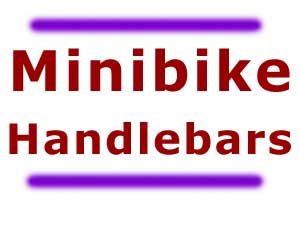
Can I Choose the Wrong Handlebars?
Choosing the wrong handlebars for your minibike can result in discomfort, reduced control, and potentially unsafe riding conditions. Here are some potential issues that can arise from choosing the wrong handlebars:
- Discomfort and Fatigue: Handlebars that are the wrong height, width, or shape for your body type and riding style can lead to discomfort and fatigue. Improperly positioned handlebars can strain your wrists, arms, and shoulders, making long rides uncomfortable and causing fatigue more quickly.
- Reduced Control and Maneuverability: Handlebars that are too wide or too narrow can affect your ability to control the motorcycle effectively. Wide handlebars may make it challenging to navigate through tight spaces or perform quick maneuvers, while narrow handlebars can reduce stability and control.
- Limited Steering Range: Choosing handlebars that are too tall or have excessive sweep can limit your steering range. This restriction can hinder your ability to turn smoothly, especially in tight corners or at low speeds.
- Interference with Controls: Handlebars that are incompatible with your motorcycle's control setup can lead to interference with switches, levers, and cables. This can impede your ability to operate the clutch, brake, or other controls properly, posing a safety risk.
To avoid these issues, it's crucial to research and choose handlebars that are appropriate for your minibike, riding style, and body measurements. Consider factors such as height, width, sweep, rise, and compatibility with control cables and wires. It's recommended to consult with experienced riders, professional bike mechanics, or handlebar manufacturers for guidance and recommendations based on your specific needs and preferences.
Ultimately, finding the right handlebars for your minibike is a personal decision that should prioritize your comfort, control, and enjoyment on the trail. Experimenting with different styles and seeking advice from experienced riders and collectors can help you discover the handlebars that bring you contentment while riding.
Enjoy the website...
About AMB
AMB is a minibike fan site dedicated to minibikes of the 1960's and 70's. We appreciate minibikes from the all the manufacturers of the time period like Arctic Cat, Rupp, Trail Horse, Sears minibikes, Suzuki minibikes, MTD minibikes, Bronco minibikes, Benelli, Manco, Kawasaki minibikes, and Ski-Wee.
See Also: Pull or Kick Start | Twist or Thumb Throttles | Minibike Articles | Minibike Lifestyle | The Minibike Handlebar




